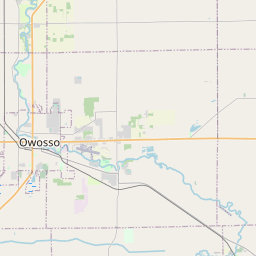Governor Parsons
Historical marker location:
318 East McNeil Street, Corunna, Michigan
( Marker is at the intersection of East McNeil Street (State Highway 71) and South Comstock Street, on the left when traveling west on East McNeil Street.)
Marker installed: 1969






© OpenStreetMap contributors
Michigan is the only state in the United States that consists of two peninsulas. The Upper Peninsula (UP) and Lower Peninsula (LP) are connected by the five-mile-long Mackinac Bridge, which is one of the longest suspension bridges in the world.
About Shiawassee County
Shiawassee County Timeline
Shiawassee County, located in the state of Michigan, has a rich and diverse history that spans over two centuries. The area was originally home to several Native American tribes, including the Ojibwe, Pottawatomi, and Wyandot. The first recorded European settlement in the area occurred in 1822 when Benjamin Rush and his family arrived from New York and established the community of Rushville. The county was officially organized in 1822 and named after the Shiawassee River that runs through it.
During the late 19th century, Shiawassee County experienced significant growth and development. The discovery of oil in 1880 led to the establishment of several oil fields, attracting many settlers and transforming the county's economy. The Detroit, Grand Haven, and Milwaukee Railway also played a crucial role in the county's growth by providing improved transportation networks and fostering trade.
In the early 20th century, Shiawassee County faced challenges brought about by the Great Depression and World War II. However, the county's agricultural sector remained resilient, with the production of corn, soybeans, wheat, and dairy products becoming the backbone of its economy. The construction of highways and the growth of the automobile industry also brought new opportunities for the county.
In recent years, Shiawassee County has continued to evolve. It has diversified its economy, with industries such as manufacturing, healthcare, and education emerging as important sectors. The county also boasts a rich cultural heritage, evident in its historical landmarks, museums, and annual events that celebrate its past. Today, Shiawassee County is a thriving community that balances its agricultural roots with modern developments, making it an attractive place to live, work, and visit.
During the late 19th century, Shiawassee County experienced significant growth and development. The discovery of oil in 1880 led to the establishment of several oil fields, attracting many settlers and transforming the county's economy. The Detroit, Grand Haven, and Milwaukee Railway also played a crucial role in the county's growth by providing improved transportation networks and fostering trade.
In the early 20th century, Shiawassee County faced challenges brought about by the Great Depression and World War II. However, the county's agricultural sector remained resilient, with the production of corn, soybeans, wheat, and dairy products becoming the backbone of its economy. The construction of highways and the growth of the automobile industry also brought new opportunities for the county.
In recent years, Shiawassee County has continued to evolve. It has diversified its economy, with industries such as manufacturing, healthcare, and education emerging as important sectors. The county also boasts a rich cultural heritage, evident in its historical landmarks, museums, and annual events that celebrate its past. Today, Shiawassee County is a thriving community that balances its agricultural roots with modern developments, making it an attractive place to live, work, and visit.
Shiawassee County Timeline
This timeline provides a glimpse into the major events and milestones that have shaped the history of Shiawassee County, Michigan.
- 1822: Shiawassee County is established and named after the Shiawassee River.
- 1827: The first settlers arrive in the county.
- 1836: Owosso becomes the county seat.
- 1851: The first railroad, the Detroit and Milwaukee Railroad, is completed in the county.
- 1863: The first oil well is drilled in Shiawassee County, leading to a brief oil boom.
- 1881: The first electric streetcars are introduced in Owosso.
- 1893: The county courthouse, known as the Shiawassee County Courthouse, is built in Owosso.
- 1930s: The Great Depression hits the county, causing significant economic hardships.
- 1950s-1970s: Manufacturing and industrial growth leads to economic development in the county.
- 1989: The Shiawassee Arts Center is established in Owosso.
- 2000s: The county experiences population growth and continues to develop its agricultural, manufacturing, and healthcare sectors.